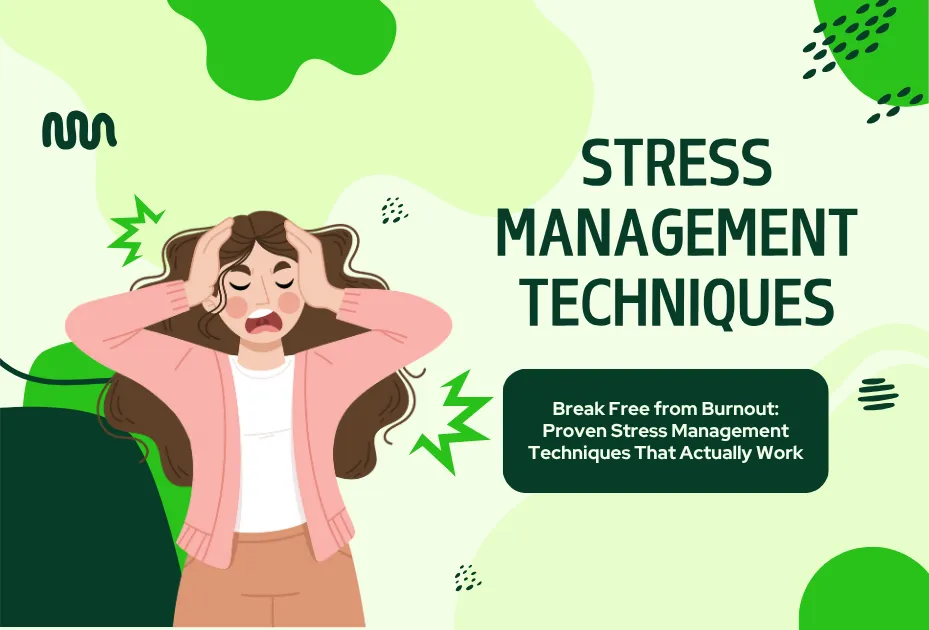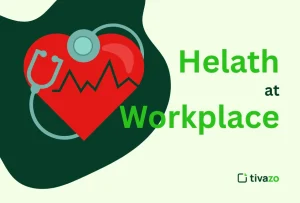The alarm goes off at 6 AM, and your phone buzzes with critical emails before your feet even hit the floor. By noon, you feel like you’re already deep in deadlines. Are you nodding your head? If so, you are experiencing what 77% of professionals routinely contend with each day—chronic stress that is a quiet thief of your performance, health, and happiness.
There are a plethora of new challenges that add stress to our lives: the isolation of working from home, information overload, social and financial pressures, and the expectation to be “always on.” Stress is a natural human reaction, but chronic stress causes enormous damage to our bodies and minds and ultimately may lead to burnout, decreased productivity, and even serious health impacts.
The good news is that there are effective stress management techniques you can do now, not the standard stress survival techniques you have heard about before, but evidence-based techniques that can be used to get you started today. In this guide, I will share some tools you can use, evidence, and practices that can help you take control of your stressors and change how you react to what life throws your way.
Understanding Stress and Its Impact
Stress is a natural response from your body to threats or stressors. When your body detects threats, it releases hormones, including cortisol and adrenaline. Stress can sometimes come in the form of acute stress, which can help you think more clearly, act quickly, or help cope with a workload. On the flip side, chronic stress is a problem.
Physically, chronic stress can create problems that may include:
- Higher blood pressure and heart rate.
- Decreased immune system functioning.
- Stomach and GI issues; headaches.
- Muscle tightness and fatigue.
- Sleep disturbances.
Mentally and emotionally, chronic stress can manifest as
- Anxiety and/or depression.
- Poor concentration and focus.
- Increased irritability and mood swings.
- Problems with short-term memory.
- Lack of motivation.
The causes of workplace stress have changed dramatically over the past few years, especially with remote work being commonplace. If you are struggling to manage workplace stress, you may be experiencing virtual meeting fatigue, blurred lines between work and home, social isolation, and consistent digital contact with colleagues. The current workplace stress phenomena may differ from the advice on managing occupational stress you have heard.
Why Conventional Recommendations Aren’t Always Effective
You may have heard many common recommendations before: “just breathe deeply,” “think positively,” “work harder if you want to get ahead,” etc. While these general suggestions are not always bad, or rather, are just based on good intentions, they often do not address the complexities of the situation.
Some common myth ideas in regard to stress management are
- What works for one person will work for all people
- Stress is only mental, and can be “thought” away
- More productivity and performance mean less stress
- Expensive hotel and spa treatments are the only way to alleviate stress
The truth is, stress management techniques should be personalized to your lifestyle, stressors, and preferences. While it may work for your colleague, it may not work at all for you, and that is perfectly acceptable.
Stress Management Techniques That Work

1.🧘 Breathing and Mindfulness Practice
When you practice deep breathing, you stimulate the parasympathetic nervous system, which will help to put the brakes on your sympathetic nervous system’s stress response. One method of deep breathing, called the 4-7-8 technique, is especially effective at quieting the body. Inhale for 4 counts, hold for 7 counts, and then exhale for 8 counts. Do it for as little as 2 minutes when your stress levels peak.

Mindfulness meditation does not always mean sitting in the lotus position for hours. You can start with just 5 minutes of guided mindfulness meditation on an app like Headspace or Calm. Research studies have shown that participants practicing mindfulness meditation for 20 minutes a day for 4 days per week lowered cortisol levels by as much as 23% and increased their emotional regulation.
Progressive muscle relaxation involves sequentially tensing and releasing muscle groups throughout the body, making you aware of where stress lives in the body while consciously releasing tension in the muscles.
2.📝 Time Management & Prioritization
Poor time management is a significant source of stress for many people. The Eisenhower Matrix is a helpful tool for sorting tasks based on Urgency and Importance, and removing the stereotype that everything should be treated like a crisis.
Strategies for more effective prioritization include

- The “Two Minute Rule“—if “it takes two minutes or less, then do it now
- Batch similar tasks together to limit context switching
- Identify realistic deadlines and buffer time
- Learn to say “No” to things and commitments that are not a high priority
Time-blocking your calendar provides structure so that you’re no longer faced with stress every time you’re determining what to do next.
3.🏃 Physical Activity and Microbreaks
Exercise is one of the strongest stress management techniques. Exercise creates endorphins, reduces cortisol, and is a good way to mentally dissipate stress hormones.
Sport has some benefits, but it does not have to be high-intensity and hardcore gym sessions. Walking for 15 minutes, stretching your body while sitting at your desk, or taking some simple stairs can all have an effect on stress. It is more important to be consistent than to be intense.
Microbreaks every 25-30 minutes can stave off excessive stressors from building up. Stand up, stretch, look outside a window, do some jumping jacks—anything! Microbreaks are those tiny interruptions throughout the day that reset your nervous system and stop stress from compounding glycolysis.
4.🛌 Sleep Hygiene and Recovery
Proper and quality sleep is absolutely essential to managing stress! Poor/sudden sleep directly correlates with increased levels of cortisol and our reactionary state when we face stressors.
Sleep Hygiene Essentials:
- Maintain consistent sleep and wake times
- Create a technology-free bedroom environment
- Keep your room cool, dark, and quiet
- Avoid caffeine 6 hours before bedtime
- Develop a relaxing pre-sleep routine
Recovery is more than sleep, too! You can build micro-recovery moments each day, such as being present and taking time to enjoy your morning coffee, actively taking a proper break at lunchtime when screen-free, and spending 5 minutes in a local natural environment.
5.💬 Social Connection & Emotional Support
Humans are biologically built for connection, and emotional support can foster resilience to stress. Loneliness impacts our ability to cope, pushing stress hormones through our bodies while increasing inflammation and decreasing our immunity. We can improve our social support:
- Schedule regular “check-ins” with friends and family.
- Join communities related to your profession or hobby.
- Consider the option of therapy or counseling as a healing resource.
- Practice being vulnerable and share your struggles with others you trust.
Even short conversations, exploring laughter and connection with a neighbor, or a quick FaceTime with a friend can release oxytocin and counter these stress hormones.
6.📵 Digital Detox & Information Overload
We’re always connected, but our nervous system does better when it can move through the cycles of relaxation and stress. With constant access to news, social media, and notifications through our devices, it’s no wonder many of us are experiencing chronic levels of low-level stress. Cultivating digital wellness through a digital detox can look like taking these steps:
- Schedule specific times for checking emails and social media.
- Maximize “Do Not Disturb” features on devices.
- Create phone-free spaces in your home.
- Unsubscribe from unnecessary (or content you don’t read) newsletters and notifications.
- Focus on “JOMO”, or the Joy of Missing Out.
How to Develop Your Personal Stress-Relief Plan

Step 1: Identify Your Stressors
For a week, write in your stress journal, noting when stress is at its peak, which situations, circumstances, times of day, or locations trigger your stress response, and how you are currently responding. In no particular order, stressors can include people, situations, times of day, or places.
Step 2: Select Strategies that Are Compatible with Your Lifestyle
Pick 2-3 stress management techniques that work for your schedule and personal preferences. If you do not enjoy sitting still and meditating, try progressive muscle relaxation. If you enjoy movement, prioritize movement or microbreaks.
Step 3: Measure Consistency Using Habit-Developing Tools
Use habit-developing apps (or journals) or even checklists to measure consistency. Start small; committing to 5 minutes a day is better than planning a 1-hour session that you will miss.
Step 4: Change and Adapt Your Plan
Your stress management plan is fluid. What you rely upon during busier times may be a different combination of exercises than you may need during less busy times. Be flexible with your plan, and play around with various exercises.
How Tivazo Can Help You Take Control of Stress
Stress management is possible with systems and tools in place. Tivazo’s full productivity system can help reduce your stress in the following ways:
- Goal Setting and Progress Tracking aid in breaking down panic-inducing projects into actionable work processes. Expectations and to-do lists can help reduce the stress of indefinite expectations.
- Team Workflow Management eliminates the burden of stress based on communication breakdowns, responsibility confusion, and blocked workflows.
- Productivity Monitoring informs you of your work process, which will allow you to identify external and internal stressors and adjust your toolbox to limit stress.
- Tivazo puts everything – tasks, goals, and team communication – in one place, so there is not as much cognitive overhead to task switching with systems as it lays the framework for stress-free productivity.
Conclusion
Stress doesn’t have to dictate your life. The stress management techniques that you have learned in this guide are not theoretical – they are real and legitimate science-backed methods that people successfully use every day.
The most elaborate stress management plan is of no value if you do not implement it consistently. Start small, choose techniques based on personal preference, and don’t focus on achieving perfection but rather on creating consistency.
Small adjustments over time can add up to a lot of stress relief. Even if your stress relief decisions are small, like taking three deep breaths before meetings that are stressful, scheduling 15-minute walks, or setting limits around digital devices, those micro-adjustments result in significant macro change.
Your journey towards stress management is unique. You will have to be patient with yourself as you find the rhythm that works best for you. The time that you invested today in effective stress management techniques will pay you back tenfold with improvements in your health, your relationships, your productivity, and your overall satisfaction with life.
Ready to Take Control of Your Stress?
Ready to take control of your stress? Explore how Tivazo can help you track, manage, and eliminate stress—starting today. Visit tivazo.com.
FAQ
What is the best quick stress relief technique?
The 4-7-8 breathing method helps relieve stress in less than two minutes. Progressive muscle relaxation, as well as short mindfulness techniques can also aid in quickly relieving stress.
Are stress management techniques effective for remote workers
Yes. Remote workers experience specific stressors, like isolation or blurred boundaries. Scheduled microbreaks, digital detox techniques, intentional social connection are effective tools for remote professionals.
What are 5 stress management techniques?
The five stress management techniques:
- Deep Breathing - Quickly calms your nervous system.
- Exercise – Releases endorphins and reduces muscle tension.
- Time Management—Reduces overwhelm by clarifying your priorities.
- Mindfulness Meditation – Which allows us to stay emotionally regulated and focused during experiences that are overwhelming.
- Limiting Screen Time – Reducing the amount of digital overload that we are exposed to will help reduce mental fatigue.
What are 7 ways to manage stress?
Seven actions that help you manage stress in a more practical manner are
- Gratitude—Reflecting on what you are grateful for on a daily (or more) level can amplify your positives.
- Connect—Finding emotional support through connecting with others is a great way to reduce your stress levels.
- Rest—Get quality sleep, whatever your routine is. Progressive Muscle
- Relaxation – A great way to relieve the symptoms of stress in the body.
- Reduce Stimulants—Cutting back on caffeine and alcohol can help reduce your stress levels.
- Routine—Having a level of routine within your life ultimately adds structure and predictability to your day.
- Follow a Hobby—Pursuing creative outlets gives you the potential to shift your focus and recharge.




